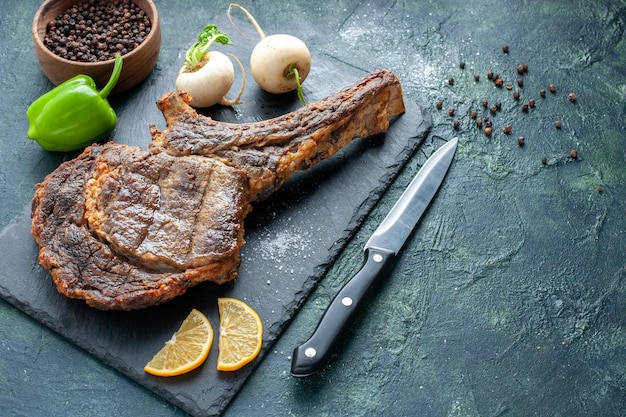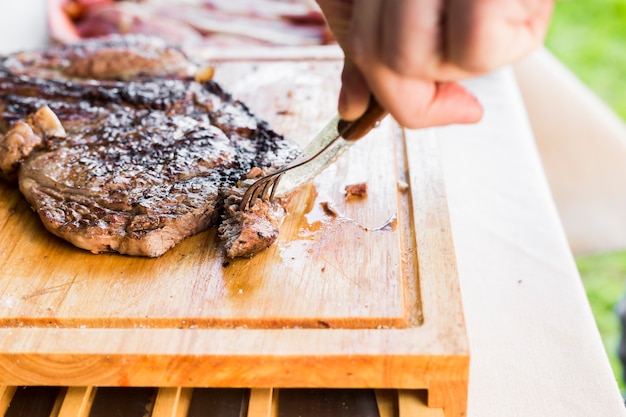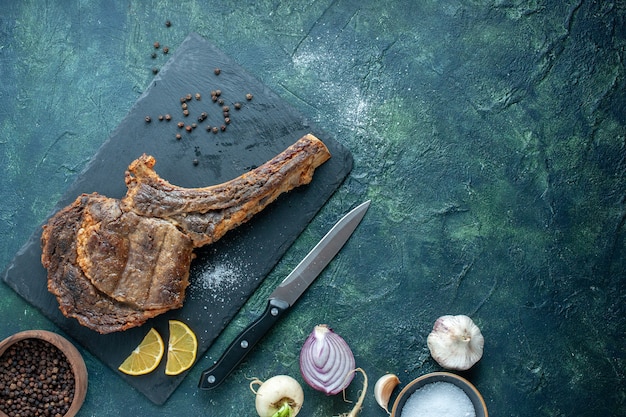There's nothing quite like a perfectly cooked top sirloin steak. That juicy, tender, and flavorful piece of beef is a culinary masterpiece, and I'm here to help you become the master chef of your own steak-cooking empire. Let's dive into the world of top sirloin and uncover the secrets to achieving steak perfection.
(Part 1) Choosing the Perfect Cut: The Foundation of a Great Steak

Understanding Top Sirloin
The first step to conquering top sirloin is understanding the cut itself. It comes from the sirloin section of the cow, located just behind the ribs. It's known for its lean profile, which means less fat, but don't let that fool you – it's still incredibly flavorful and tender due to the marbling, those little streaks of fat that run through the meat.
Graded for Excellence: Navigating the Beef Grades
Now, let's talk about those grades you see on the meat packaging. They're like a quality stamp, letting you know what to expect. There's "Select," which is a good everyday option. Then there's "Choice," the step up, with more marbling and a richer flavor. And finally, the top tier, "Prime," offering the most marbling and a truly indulgent experience. For a top sirloin, you'll typically find it in "Choice" or "Prime," depending on where you shop and your budget.
Size Matters: The Thickness Factor
The thickness of your top sirloin steak plays a crucial role in how it cooks. For an ideal outcome, I recommend aiming for a steak around 1 inch thick. This gives you the perfect balance of cooking time and even heat penetration, ensuring a delicious, evenly cooked center.
(Part 2) Prepping Your Steak for Success

The Pat-Down: Drying for Even Cooking
Before you get carried away with seasoning, there's a crucial prep step that often gets overlooked: patting the steak dry. Think of it as a little bit of a spa treatment for your meat. By gently patting it with paper towels, you're removing excess moisture, preventing steam from forming and leading to uneven cooking.
Room Temperature Indulgence: Letting the Steak Relax
Here's a tip from the pros: let your steak rest at room temperature for about 30 minutes before cooking. This might sound counterintuitive, but it's a game-changer. Allowing the steak to come to room temperature helps it cook more evenly, resulting in a perfectly tender and flavorful center.
Salt and Pepper: The Foundation of Flavor
Now, let's get to the heart of seasoning: salt and pepper. I'm a minimalist when it comes to seasonings, and good quality salt and freshly ground pepper are all you really need. Season liberally on all sides of the steak, making sure every inch gets a good coat.
Beyond Basics: Exploring Flavor Adventures
For those who like to experiment, the world of seasonings is your oyster. Garlic powder, onion powder, paprika, and blends of herbs can add extra layers of flavor. But remember, the goal is to enhance the steak's natural flavor, not overpower it. Start with small amounts and taste as you go.
(Part 3) cooking techniques: Bringing Your Steak to Life

Grilling: The Classic Steakhouse Experience
Grilling is the quintessential steak-cooking method. It's all about that smoky char and juicy interior. Get those coals roaring hot, and your steak will be ready in a flash. I typically grill for about 4 minutes per side for medium-rare. But remember, cooking times can vary depending on your grill's heat and the thickness of your steak.
Pan-Searing: Quick, Easy, and Delicious
If you don't have a grill, pan-searing is a fantastic alternative. Grab a cast-iron skillet, heat it up until it's smoking hot, and add a splash of oil. Sear the steak for 3-4 minutes per side, creating a beautiful crust and locking in the juices.
Oven-Roasting: A Gentle Approach for Thicker Cuts
For those thicker steaks, oven-roasting offers a gentle and controlled cooking experience. Preheat your oven to 400°F (200°C), place the steak on a rack in a roasting pan, and roast for about 15-20 minutes, or until it reaches your desired internal temperature.
(Part 4) The Importance of Temperature: Ensuring Steak Perfection
The meat thermometer: Your Steak-Cooking Ally
Let's face it, a meat thermometer is your best friend in the world of steak cooking. It eliminates any guesswork, ensuring that your steak is cooked to your exact preference.
The Doneness Guide: Finding Your Steak Sweet Spot
Here's a handy guide to internal temperatures, so you know exactly what to aim for:
| Doneness | Internal Temperature (°F) |
|---|---|
| Rare | 125-130 |
| Medium Rare | 130-135 |
| Medium | 135-140 |
| Medium Well | 140-145 |
| Well Done | 145-150 |
Resting Time: Allowing the Juices to Redistribute
After your steak is cooked to perfection, resist the temptation to slice it right away. Let it rest for about 10 minutes. During this time, the juices will redistribute throughout the meat, resulting in a more tender and juicy steak.
(Part 5) Delicious Sauces and Sides: Elevating Your Steak Experience
steak sauce: The Perfect Complement
A good steak sauce is like a finishing touch, adding a burst of flavor and enhancing the steak's natural deliciousness. I'm a big fan of horseradish sauce, but the options are endless. Experiment with different blends of herbs, spices, and wine to create your signature sauce.
side dishes: Completing the Culinary Symphony
What's a steak without some incredible side dishes to accompany it? Here's a list of options to get your culinary creativity flowing:
- Roasted vegetables like asparagus, broccoli, or Brussels sprouts offer a vibrant and healthy contrast to the rich steak.
- mashed potatoes provide a creamy and comforting element, perfectly complementing the steak's savory flavors.
- baked potatoes, classic and satisfying, offer a hearty and filling side dish.
- A simple green salad adds freshness and lightness to the meal.
- grilled corn on the cob adds a touch of smoky sweetness and complements the steak's savory profile.
(Part 6) Mastering the Art of steak cutting: Slicing for Tenderness
A Sharp Knife: The Key to Perfect Slices
A sharp knife is essential for slicing steak, ensuring clean cuts without tearing or shredding the meat. A serrated knife is the ideal tool for the job, gliding effortlessly through the fibers.
Cutting Against the Grain: Unlocking Tenderness
Here's a crucial tip that makes all the difference: cut against the grain. This means slicing across the muscle fibers, which makes the steak easier to chew and ensures a more tender and enjoyable eating experience.
(Part 7) My Steak-Cooking Journey: Lessons Learned Along the Way
Early Attempts: A Steak-Cooking Odyssey
My first steak-cooking adventure was a bit of a disaster. Let's just say it was more charcoal than steak. I learned that patience and precision are key when cooking meat.
Learning from Others: The Value of Experience
Over the years, I've learned from experienced cooks, devoured cookbooks, and even taken a few cooking classes. There's so much knowledge to be gained from others, but remember, every chef has their own unique style.
Experimentation is Key: Embrace the Journey
The best way to master the art of steak cooking is to experiment. Don't be afraid to try different cooking techniques, seasonings, and even cuts of meat. Each attempt, regardless of the outcome, is a learning experience.
(Part 8) Troubleshooting and Tips: Addressing Common Steak-Cooking Challenges
Steak Too Tough? Rescue Strategies
If your steak turns out tough, chances are it was overcooked. Don't despair! You can still salvage it by slicing it thinly and using it in a stir-fry or sandwich, adding a burst of flavor to your dish.
Steak Too Dry? Adding Back Moisture
A dry steak usually means it was cooked for too long or at too high a temperature. You can reintroduce moisture by adding a sauce or topping it with a few tablespoons of butter, giving it a rich and flavorful finish.
Steak Not Cooked Evenly? Ensuring Consistent Heat
Uneven cooking can be caused by uneven heat distribution or a steak that's too thick. Use a meat thermometer to ensure even cooking, and adjust the heat accordingly.
FAQs
What's the best way to tell if a steak is cooked to my liking?
The most reliable way to determine doneness is with a meat thermometer. Insert it into the thickest part of the steak and check the internal temperature against the doneness guide provided earlier.
What if I don't have a meat thermometer?
If you don't have a meat thermometer, you can use the "touch test" to get a rough idea of the steak's doneness. Gently press the center of the steak with your finger.
If it feels firm, it's well done.
If it feels slightly firm, it's medium-well.
If it feels soft and springy, it's medium-rare.
If it feels very soft and squishy, it's rare.
What's the difference between "choice" and "select" steak?
"Choice" and "select" are grades of beef, with "choice" being the higher grade. "Choice" beef has more marbling than "select" beef, which means it will have a richer flavour and be more tender.
Should I marinate my steak before grilling?
You can marinate your steak, but it's not necessary. Marinades can add flavour and tenderness, but they can also make it difficult to get a good sear. If you do marinate, make sure to pat the steak dry before grilling.
Can I freeze a top sirloin steak?
Yes, you can freeze a top sirloin steak. Wrap it tightly in plastic wrap or freezer paper and store it in the freezer for up to 3 months. Remember to thaw it in the refrigerator for 1-2 days before cooking.
There you have it, my fellow steak enthusiasts. With these tips and techniques, you'll be well on your way to becoming a steak-cooking maestro. So, fire up the grill, grab your favorite seasonings, and get ready to enjoy a truly delicious meal. Happy cooking!
Everyone is watching

Corn on the Cob: The Ultimate Guide to Perfectly Cooked Ears
Healthy MealsAh, corn on the cob. Just the name evokes images of sunny days, barbecues, and that sweet, juicy flavour that ...

Perfect Pork Roast Oven Cooking Time: A Guide to Delicious Results
Healthy MealsThere's something truly satisfying about a perfectly roasted pork. The aroma alone is enough to make your mout...

Ham Cooking Time: How Long to Bake, Smoke, or Boil a Delicious Ham
Healthy MealsAh, ham. It's a classic, isn't it? A real crowd-pleaser, especially around holidays. And when done right, it'...

Scallops: The Ultimate Guide to Perfect Cooking
Healthy MealsAh, scallops. Those delicate, sweet, and utterly delicious morsels of the sea. They hold a special place in my...

Spaghetti Squash: The Ultimate Guide to Cooking and Serving
Healthy MealsRemember that time you saw spaghetti squash at the supermarket, looking all bumpy and strange, and thought, "W...
